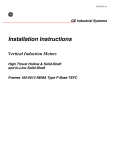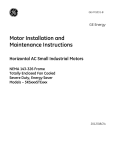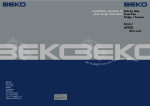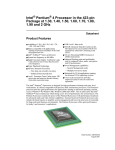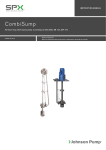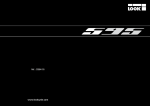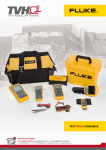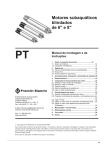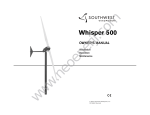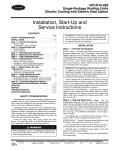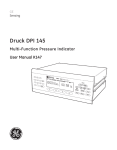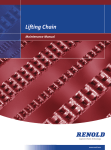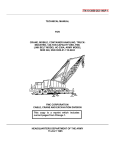Download GE K-95352 User's Manual
Transcript
GEK-95352 GE Industrial Systems Instructions Vertical Induction Motors High Thrust Hollow and Solid-Shaft In-Line Solid-Shaft Frames 444-5011 NEMA Type P Base Weather Protected Type I and Type II GEK-95352 CONTENTS Subject Page Safety Precautions ...................................................................................................................................... 3 Introduction................................................................................................................................................ 4 Cross-Sectional Drawings..............................................................................................................24, 25, 26 Receiving, Handling and Storage ................................................................................................................ 5 Unpacking ............................................................................................................................................... 5 Installation.................................................................................................................................................. 6 Location and Mounting............................................................................................................................ 6 Pump and System Precautions.................................................................................................................. 6 Alignment of Solid-Shaft Motors ............................................................................................................. 7 Couplings for Hollow-Shaft Motors ......................................................................................................... 7 General ................................................................................................................................................. 7 Self-Release Couplings ......................................................................................................................... 7 Bolted Couplings .................................................................................................................................. 9 Non-Reverse Couplings ........................................................................................................................ 9 Power Supply and Connections .............................................................................................................. 10 Wiring and Grounding ........................................................................................................................ 10 Allowable Voltage and Frequency....................................................................................................... 10 Position of Conduit Box...................................................................................................................... 11 Lubrication ............................................................................................................................................ 11 Water Cooling ....................................................................................................................................... 11 General ............................................................................................................................................... 11 Oil Cooling Coil Connections ............................................................................................................. 11 Connection Fitting Drawing ................................................................................................................ 12 Operation.................................................................................................................................................. 12 Safety Warnings .................................................................................................................................... 12 Steps Prior to Initial Start-Up ................................................................................................................. 12 Initial Start............................................................................................................................................. 14 Jogging and Repeat Starts ...................................................................................................................... 14 Maintenance ............................................................................................................................................. 15 Safety Warning...................................................................................................................................... 15 General.................................................................................................................................................. 15 General Cleanliness ............................................................................................................................... 15 Coupling Maintenance ........................................................................................................................... 15 Relubrication ......................................................................................................................................... 16 Oil Viscosity (Table II) .......................................................................................................................... 17 End-Play Adjustment ............................................................................................................................. 17 General ............................................................................................................................................... 17 Ball Thrust Bearings ........................................................................................................................... 17 Spherical Roller Thrust Bearings......................................................................................................... 18 Bearing Replacement ............................................................................................................................. 19 Oil Cooling Coil Maintenance................................................................................................................ 19 Insulation and Windings ........................................................................................................................ 20 General ............................................................................................................................................... 20 Vacuum and Compressed Air Cleaning ............................................................................................... 21 Cleaning with Water and Detergent..................................................................................................... 21 Cleaning with Solvents ....................................................................................................................... 21 Revarnishing Windings ....................................................................................................................... 22 Renewal Parts........................................................................................................................................... 22 Trouble-Shooting Chart ............................................................................................................................ 23 2 GEK-95352 Safety Precautions High voltage and rotating parts can cause serious or fatal injury. Installation, operation and maintenance of electric machinery should be performed by qualified personnel. Familiarization with NEMA Publication MG-2, Safety Standard for Construction and Guide for Selection, Installation and Use of Electric Motors and Generators, the National Electrical Code and sound local practices is recommended. • Be sure that the shaft key is fully captive before the motor is energized. • Avoid extended exposure in close proximity to machinery with high noise levels. • Use proper care and procedures in handling, lifting, installing, operating and maintaining the equipment. • Do not lift anything but the motor with the motor lifting means. For equipment covered by this instruction book, it is important to observe safety precautions to protect personnel from possible injury. Among the many considerations, personnel should be instructed to: Safe maintenance practices with qualified personnel are imperative. Before starting maintenance procedures, be positive that: • Avoid contact with energized circuits or rotating parts, • Avoid by-passing or rendering inoperative any safeguards or protective devices, • Avoid use of automatic-reset thermal protection where unexpected starting of equipment might be hazardous to personnel. • • Equipment connected to the shaft will not cause mechanical rotation, • Main machine windings and all accessory devices associated with the work area are disconnected from electrical power sources. If a high potential insulation test is required, procedures and precautions outlined in NEMA Standards MG-1 and MG-2 should be followed. Failure to properly ground the frame of the machine can cause serious injury to personnel. Grounding should be in accordance with the National Electrical Code and consistent with sound local practice. Avoid contact with capacitors until safe discharge procedures have been followed. These instructions do not purport to cover all of the details or variations in equipment nor to provide for every possible contingency to be met in connection with installation, operation or maintenance. Should further information be desired or should particular problems arise which are not covered sufficiently for the purchaser’s purposes, the matter should be referred to the General Electric Company. 1988, 1999 General Electric Company 3 GEK-95352 I. INTRODUCTION General Electric high-thrust vertical motors covered by these instructions are carefully constructed of high-quality materials and are designed to give long and trouble-free service when properly installed and maintained. These motors are generally used to drive pumps. thrust and one or two oriented to carry down-thrust. If greater down-thrust capacity is required, motors may use one or two standard angular-contact ball bearings and one split-race bearing which gives the capacity of two or three bearings down and one bearing up. This does, however, give more end-play than normal. Both HOLLOW-SHAFT and SOLIDSHAFT motors are described in this instruction book. Figure 1 shows a typical hollow-shaft high-thrust motor. The solidshaft construction is similar except that the top half-coupling is omitted, and the motor shaft extends out the bottom of the motor. See Figure 2. Solid-shaft highthrust motors are not suitable for driving loads that impose significant radial load on the motor shaft; they should not, for example, be used for belt-drive applications. IN-LINE motors (designed to be mounted on pumps which are directly in the pipeline, and hence called IN-LINE motors) are also covered by this instruction book. These motors have two opposed-mounted angular-contact ball thrust bearings at the top end of the motor so they can carry either up or down thrust. The lower guide bearing is a radial-ball type and also carries any radial load imposed by the pump. IN-LINE motors are always of the solidshaft type. This construction is shown on the left side of Figure 3. Motors may be supplied with different bearing arrangements for various external thrust conditions imposed by the pump, such as different magnitudes of downthrust and either momentary or continuous up-thrust. A typical high-thrust motor with angular-contact ball bearings is shown in Figure l. This standard construction is for high continuous downthrust and is suitable for momentary upthrust equal to 30% of the rated downthrust capacity of a high-thrust motor. NOTE THAT ANGULAR-CONTACT BEARINGS CAN ONLY CARRY THRUST IN ONE DIRECTION. Spherical-roller bearings are sometimes used for applications requiring extra high down-thrust capacity and/or extra bearing life; these bearings may require watercooling. See Figure 2. Motors with spherical-roller thrust bearings also require certain minimum down-thrust during all continuous operation. Since overloading greatly reduces bearing life, the amount of thrust applied should not exceed the recommended values. This instruction book applies to motors with either Weather-Protected I or Weather-Protected II enclosures as defined by NEMA. Both of these are “open" motors. (WP-II enclosure is not available in 440 frame series.) Figure 3 shows a typical solid-shaft highthrust construction (on right side) for applications requiring continuous up-anddown thrust capability. In this type of motor, two or three angular-contact ball bearings are mounted in opposed mounting with one bearing oriented to carry up- Weather-Protected I motor construction is shown in Figure 1 for 500 frame motors and in Figure 3 for 440 frame motors. 4 GEK-95352 II. Weather-Protected II motor construction is shown in Figure 2. This enclosure is characterized by additional protection at the air inlet and outlet passages and by gaskets, drains, and other features to make it suitable for use outdoors in severe climates. Filters can be supplied for the air-inlet openings. When used, they should be cleaned periodically, since clogged filters restrict the amount of cooling air and cause the motor to overheat. Gages are sometimes used to measure the pressure drop across the filter and thus indicate its condition. Filters should be cleaned when the gage reads over 0.4” of water. the bearings, but if the storage period is to exceed three months, the reservoirs should be filled. It is suggested that such oil-filled motors be conspicuously tagged in order to prevent mishandling, which would cause oil spillage and subsequent damage to the internal parts of the motor. When filling for storage, fill to the maximum level shown on the gage or approximately ½” over the mark showing the standstill level. Before operating the motor, drain this oil and refill with fresh oil. RECEIVING, HANDLING AND STORAGE During storage, windings should be protected from excessive moisture absorption by some safe and reliable method of heating. Space heaters, if supplied, may be used for this purpose. The temperature of the windings should always be maintained a few degrees above the temperature of the surrounding air. It is recommended that motors in storage be inspected, the windings meggered, and a log of pertinent data kept. Any significant decrease in insulation resistance should be investigated. See instructions under RELUBRICATION for oil recommendations. Each motor should be carefully examined when received and a claim filed with the carrier for any damage. The nearest office of the General Electric Company may offer guidance. The motor should be lifted by the lugs provided. These lugs are intended for lifting the motor only and must not be used to lift any additional weight. Be careful not to touch overhead equipment. Failure to observe this warning may result in personal injury or death. If a motor is to be in storage for over one year, it is recommended that competent technical inspection service be obtained to ensure that the storage has been adequate and that the motor is suitable for service. Contact your nearest General Electric Sales office to arrange for inspection service. If the motor is not to be installed immediately, it should be stored in a clean, dry location. Precautions should be taken to prevent the entrance of moisture, dust, or dirt during storage and installation. Precautions are taken by the factory to guard against corrosion. The machined parts are slushed to prevent rust during shipment. Examine the parts carefully for rust and moisture, if the equipment is to be stored, and re-slush where necessary. A. Unpacking If the machine or machine parts have been exposed to low temperature, unpack it only after it has reached the temperature of the room in which it will be unpacked or located; otherwise sweating will occur. Motors are shipped without oil in the bearing reservoirs. An oil film remains on 5 GEK-95352 III. INSTALLATION If ignitable dust or lint is present the surface temperature of space heaters, if supplied, should not exceed 80% of the ignition temperature. Refer to space heater nameplate or factory for information on surface temperature. Dust and-or lint should not be allowed to build up around the surface of space heaters. Failure to observe these precautions may result in damage to equipment, injury to personnel or both. Installation should be in accordance with the National Electrical Code and consistent with sound local practices. Coupling guards should be installed as needed to protect against accidental contact with moving parts. Machines accessible to personnel should be further guarded by screening, guard rails, or other suitable enclosure to prevent anyone from coming in contact with the equipment. This is especially important for motors that are remotely or automatically controlled or have automatic resetting overload relays, since such motors may start unexpectedly. Failure to observe these precautions may result in injury or death to personnel. A. A. Pump and System Precautions Some precautions are necessary to assure satisfactory operation of motors in pumping service. The packing gland in the pump head should be kept in good condition so that the liquid being pumped will not be forced out along the shaft and enter the motor through the lower bearing housing. Location and Mounting Allow enough space around the motor to permit free flow of ventilating air and to maintain an ambient temperature not over 40° C. Where a choice of locations is possible, install the motor so that it will be subjected to the least amount of dirt, dust, liquids, or other harmful materials. Mount the motor securely on a level, firm foundation, align accurately with the driven equipment, and tighten mounting bolts securely. Motors driving pumps in pressure systems where the pressure is maintained after shutdown should be protected from over speeding by check valves, or nonreverse couplings. Installation of the machine where hazardous, flammable, or combustible vapors or dusts present a possibility of explosion or fire should be in accordance with the National Electrical Code, Articles 500-503, and consistent with sound local practices. Extreme care is required for machines supplied with an explosion-proof or dust-ignition proof accessory device or conduit box since any nicks or burrs in the sealing surfaces during disassembly and reassembly may destroy the explosion-proof or dustignition proof features. Failure to observe these precautions may result in damage to the equipment, injury to personnel, or both. Weather-Protected Type I motors may be installed in indoor locations with relatively high moisture content or sheltered outdoor locations in dry climates. Weather-Protected Type II motors may be installed outdoors. Use filters in unclean areas. 6 GEK-95352 The SYSTEM REED CRITICAL FREQUENCY should be 25% above or below motor operating speed in order to avoid excessive vibration. C. To prevent breakage, coupling bolts must be tightened to torque values indicated below for bolted or nonreverse couplings Bolt Size 1/2 5/8 3/4 1 Alignment of Solid-Shaft Motors Accurate mechanical lineup is essential for successful operation. Mechanical vibration and roughness when the motor is running may indicate poor alignment. In general, lineup by straight edge across, and feeler gages between coupling halves is not sufficiently accurate. It is recommended that the lineup be checked with dial indicators. The space between coupling hubs should be maintained as recommended by the coupling manufacturer. D. It shall be the installer’s responsibility in all cases to ascertain that these torque values are used and maintained. This shall include those instances when the coupling comes mounted in the motor. Failure to comply may cause the coupling bolts to break, with resultant extensive damage to the equipment. Couplings for Hollow-Shaft Motors 1. Torque 90 lb-ft 180 lb-ft 320 lb-ft 710 lb-ft 2. Self-Release Couplings Should the motor accidentally be run in the reverse direction, the pump line-shaft joints may unscrew. The self-release coupling acts to limit the amount of this unscrewing. In normal operation, torque from the motor is transmitted by the lower half-coupling through the driving pins to the upper half-coupling, and then to the pump shaft. If reversal occurs and the pump shaft starts to unscrew and lengthen, the upper half of the self-release coupling is lifted up off of the driving pins, thus uncoupling the pump from the motor. See Figure 1, where a selfrelease coupling is shown to the left of the shaft center-line. General Vertical hollow-shaft motors are designed for driving deep-well, turbine-type pumps and can be equipped with either self-release, bolted, or non-reverse couplings as described in following sections. These couplings are located at the top of the motor and allow pump impeller position to be adjusted easily. The type of coupling is specified by the customer. Remove the top cap for access to the coupling. Two slots are provided in the outside rim of the coupling so that a bar can be inserted to keep the assembly from turning while the adjustment of pump impeller clearance is being made. A coupling bolt can be screwed into one of the extra tapped holes in the top endshield to provide a stop for the bar. NOTE : THAT SELF-RELEASE COUPLINGS CANNOT CARRY UPTHRUST Proper functioning of a self-release coupling depends upon several factors. The pump shaft adjusting nut must be securely attached to the top 7 GEK-95352 Table 1 half-coupling, and the top halfcoupling must not bind on the lower half. Otherwise, the adjusting nut lock-screw may break instead of the coupling halves separating. Should this happen, the motor would continue to drive the pump line shaft, and the joints would continue to unscrew. Serious damage to both motor and line shaft may result. Clearance between the coupling halves should be checked by placing the top half-coupling in position prior to installing the motor. It should drop into place, and rest solidly on the lower half-coupling, without forcing. Frame Size 444-449 509-5011 XH 4.38” 4.88” Depending upon the circumstances causing reversal and upon which line-shaft joint unscrews, there may be enough energy stored in the rotating parts, at the time the coupling clears the pins, to cause the pump shaft to continue to rise and strike the top cap. However, if the above conditions are met, damage, even in the most severe cases, should be limited to a broken cap. It is intended that self-release couplings will be called upon to uncouple only infrequently. Proper alignment of the pump headshaft within the motor hollow shaft is also important. After the coupling releases it no longer holds the pump shaft centered. If the alignment is not good, the motor shaft which is still rotating may rub the pump shaft which has stopped, and damage will result. NOTE: ANY TIME A SELF-RELEASE COUPLING UN-COUPLES, IT IS NECESSARY T0 REMOVE ALL POWER AND MANUALLY RECOUPLE. Uncoupling is most frequently caused by application of singlephase power after a power supply disturbance, while the motor is being driven in the reverse direction by the pump; this single-phase power causes the motor to take over and drive the pump in the reverse direction and the pump shaft joints will then unscrew. To prevent this, select a motor starter which requires a manual start after any stop (rather than allowing automatic re-start as soon as power is applied to the starter), or incorporates a back-spin timer to keep power from being automatically reapplied to the motor until enough time has elapsed for water back-flow through the pump to stop and for the motor to completely stop. A third requirement is that the distance between the top of the pump shaft and the inside of the top cap be at least enough to allow the top halfcoupling, when it tries to release, to clear the pins before the shaft hits the cap. Check this clearance after the adjusting nut has been drawn up to its final position. To facilitate making the check, the motor outline print shows a maximum dimension "XH" from the top of the coupling to the top of the pump shaft. Adhering to this design limit will allow the shaft and coupling to lift enough to clear the pins and still leave a small clearance between the shaft and cap. For standard motors, “XH” is as shown in Table 1. 8 GEK-95352 Power supply phase-sequence reversal will also cause the motor to reverse and unscrew the pump shaft, but this rarely occurs. An antiphase-reversal relay can be incorporated in the motor controller if desired. from unscrewing, but it also prevents damage from overspeeding and damage to water-lubricated pump shaft bearings, when during shutdown the residual water in the system drives the pump in the reverse direction. This type of coupling also allows up-thrust from the pump to be carried by the motor bearings. Motor torque is transmitted to the pump shaft through the two halves of the coupling which are bolted together. See required bolt torques. To prevent uncoupling on initial start-up, check motor rotation direction before installing the upper halfcoupling to be sure direction is correct. To reverse direction of rotation, interchange any two power leads. 2. The operation of a non-reverse coupling is explained as follows. When the motor is started in the correct or forward direction, the ratchet pins are lifted by the ratchet teeth, and are held up by centrifugal force and friction when motor speed becomes high enough. When power is removed, the speed decreases, and the pins fall. At the instant of reversal, a pin will catch on a ratchet tooth and prevent backward rotation. The number of pins differ from the number of teeth to multiply the number of stopping positions. Bolted Couplings Bolted couplings allow up-thrust from the pump to be taken by the motor bearings. This type of coupling is similar to a self-release coupling except that the driving pins are replaced by bolts, which should be securely tightened to hold the two halves of the coupling solidly together so that torque is transmitted by face friction. See torque requirements. This type of coupling does not have the self-release feature and allows reverse rotation. A very rapid decrease in speed can result in acceleration forces great enough to prevent the pins from dropping. This condition is further aggravated when the pins become dirty, and their action sluggish. If the time from shutdown (the instant the “stop” button is pressed) to zero speed is greater than two seconds, operation will be satisfactory. See the self-release coupling shown to the left of the motor centerline in Figure 1, which is applicable to bolted couplings except that the headless drive pins are replaced by bolts as explained above. 4. Non-Reverse Couplings The non-reverse type of coupling, as shown to the right of the motor centerline in Figure 1, is also a bolted type, and, in addition, it keeps the pump and motor from rotating in the reverse direction. Thus, it not only prevents the pump shaft To permit operation when stopping time is less than two seconds, the pins are spring-loaded. For those cases involving cycling (frequent starting and stopping) and stopping times greater than two seconds, the 9 GEK-95352 springs may be removed to decrease wear on the ratchet plate. When installing a non-reverse coupling do not use lubricant. Lubrication will lower the coefficient of friction between pins and pincarrier, and the pins may not stay up when motor reaches full speed. Pins and springs are made of heattreated stainless steel. A complete non-reverse coupling consists of a self-release coupling plus a non-reverse assembly, which includes pin carrier, pins, springs, pin retaining plate, and cap-screws. On motors covered by this instruction book, the ratchet teeth are an integral part of the endshield cover casting. Motors shipped from stock may have their top couplings and nonreverse assemblies packaged separately. They can be installed as described in previous paragraphs. E. Power Supply Connections 1. A self-release or a bolted coupling can be converted to a non-reverse coupling without disturbing the adjustment of the pump shaft nut. The non-reverse aAssembly will normally be received as a unit. To assemble it onto the motor, loosen the 3 small capscrews that hold the pinretaining plate so this plate can be centered during assembly. Next, remove the drive-pins or bolts from the lower half-coupling. Then slide the non-reverse assembly down over the top half-coupling. Next insert the long cap screws through the plate, pin carrier, and top coupling and into the lower coupling. Tighten them securely so that torque will be transmitted by friction between the coupling faces rather than through the bolts. See TORQUE REQUIREMENTS. Finally tighten the 3 small capscrews to secure the pin-retaining plate. Wiring and Grounding Motor and control wiring, overload protection, and grounding should be in accordance with the National Electrical Code and consistent with sound local practices. Failure to observe these precautions may result in damage to the equipment, injury to personnel, or both. Stator winding connections should be made as shown on the connection diagram or in accordance with the wiring diagram attached to the inside of the conduit box cover. For 3lead motors no connection diagram is needed or supplied. The motor frame may be grounded by attaching a ground strap from a known ground point to the bronze grounding bolt in the conduit box. 2. The top half of the coupling should seat solidly on the lower half and the pins should touch the bottom of the pockets between the teeth in the ratchet. The clearance between the pin-carrier and the top of the ratchet teeth should be between 1/16 and 1/8”. Allowable Voltage and Frequency The power supply must agree with the motor nameplate voltage and frequency. Motors will operate (but with characteristics somewhat different from nameplate values) on line voltages within + l0% of nameplate value or frequency within 10 GEK-95352 + 5% and a combined variation not to exceed + 10%. 3. Whenever the motor is running, enough water should be circulated through the coil to keep the steady oil-bath temperature below 150° F (65°C). Position of the Conduit Box When mounting conditions permit the conduit box may be turned so that entrance can be made upward, downward, or from either side. F. The maximum pressure and maximum temperature allowable for cooling water are also shown on the nameplate or instructions. Exceeding these values may damage the coil or give insufficient cooling of the lubricating oil. Use only pure, clean water unless the motor was specifically ordered to have a coil and fittings of special material to withstand corrosive water. Standard cooling coils are made from type 'K" copper tubing with wall thickness of 0.050”. Lubrication Motors with oil-lubricated bearings are shipped without oil. Before starting the motor, fill each reservoir to the standstill level shown on the sight gage. Be careful to keep dirt out of the lubricant and bearing housing. Use only the oil specified on the lubrication nameplate or the lubrication instruction supplied with each motor. See RELUBRICATION, TABLE II and LUBE NAMEPLATE for oil grade and viscosity and further instructions. When the motor is shut down during freezing weather, blow any remaining water out of the coil. 2. If reservoirs have had oil in them during storage period, drain out this old oil when installing the motor for operation. G. As indicated above, a cooling coil is used to keep oil in the bearing reservoir cool. Water at pressures as high as 100 PSI is circulated through the coil. It is imperative, there for, that all joints be tight and that there be no leaks. A pin-hole leak will quickly allow enough water to overflow into interior of motor and cause motor failure. Water Cooling 1. Oil Cooling Coil Connection General If a bearing requires auxiliary water cooling, the oil reservoir will be provided with a cooling coil whose ends are brought out to fittings in the end-shield wall (see Figure 2). Motors covered by this instruction book are furnished with inlet and outlet connection fittings designed to prevent inadvertent loosening of internal joints or undue stress on the internal piping when external water supply pipes are connected to the motor. The lubrication nameplate or instruction will specify the required water flow and the maximum water flow in gallons per minute. Exceeding this maximum flow could cause deterioration of the cooling coil. 11 GEK-95352 IV. See Figure 4 and the following paragraphs for further instructions. Also see maintenance instructions. OPERATION Before energizing the motor for the first time or after an extended shutdown, it is advisable to check insulation resistance, power supply and mechanical freedom of the motor. If the motor has been stored in a damp location, dry it out thoroughly before operating. To make water connections, simply remove the pipe plugs (furnished for shipping) from brass fittings B and make connection to female pipetapped hole in accordance with applicable codes and good practice. TIGHTEN CONNECTIONS SESECURELY BUT NOT EXCESSIVELY. It is recommended that the upper fitting be used for inlet and lower fitting for drain. Be sure that the motor is not running and the power supply is disconnected before working on motor. A. DO NOT LOOSEN SCREWS F OR REMOVE PART B WHEN CONNECTING WATER SUPPLY TO MOTOR: PART B MUST BE FULLY SEATED AGAINST PART A TO COMPRESS THE WATER/OIL SEALING O-RING. Part A is screwed into the endshield wall and locked with set-screws E -when making water connection check part A to be sure it is tight and there are no oil leaks around it. Since there is no solid connection between parts A and C, inadvertent loosening of internal connections is minimized. Steps Prior to Initial Start-Up or After a Long Idle Period 1. Check insulation resistance as indicated in the caution above. Before measuring insulation resistance the machine must be at standstill and all windings to be tested must be electrically connected to the frame and to ground for a time sufficient to remove all residual electrostatic charge. Failure to observe these precautions may result in injury to personnel. In accordance with established standards, the recommended minimum insulation resistance for the stator winding is as follows: VS RS = +1 1000 Where RS is the recommended minimum insulation resistance in megohms at 40º C of the entire stator winding obtained by applying direct potential to the entire winding for one minute, and VS is rated machine voltage. COOLING COIL CONNECTION FITTINGS 12 GEK-95352 and LUBE NAMEPLATE on motor for oil grade and viscosity and further instructions. Be sure filler caps and drain plugs are securely tightened. NOTE SEE IEEE RECOMMENDED PRACTICE FOR TESTING INSULATION RESISTANCE OF ROTATING MACHINES, PUBLICATION NO. 43, FOR MORE COMPLETE INFORMATION. 3. Whenever possible, examine the interior of the machine for loose objects or debris which may have accumulated, and remove any foreign material. If the insulation resistance is lower than this value, it may be wet and it is advisable to eliminate the moisture in one of the following ways: a. Dry the stator in an air circulating oven with the air surrounding the part at 95ºC to 115ºC until the stator has been above 90º C for at least four hours. Then the air temperature may be raised to 135ºC to 1 15ºC. Continue to heat until the insulation resistance is constant for a one-half hour period. 4. If possible, turn the rotor by hand to be sure that it rotates freely. b. Enclose the motor with canvas or similar covering, leaving a hole at the top for moisture to escape. Insert heating units or lamps and leave them on until the insulation resistance is constant for onehalf hour period. Be careful not to get heating units so close to the winding that they cause localized damage. 6. Check water-cooling connections, flow, and temperature. 5. Check all connections with the connection diagram. Check all accessible factory-made connections for tightness to make sure none has become loose during shipment. 7. If possible leave motor uncoupled (or uncouple it) for initial operation so that motor vibration, noise, current and bearings can be checked uncoupled before they are masked by the pump. To run a VHS motor uncoupled, it is recommended that the pump head-shaft be removed. If this cannot be done remove the upper half-coupling and be sure the pump shaft is well centered in the motor shaft so it will not rub. IF THIS IS DONE, ROTATE MOTOR BY HAND TO BE SURE THERE IS NO INTERFERENCE BETWEEN SHAFTS. Do not try to run motor uncoupled by just removing gib-key. c. With the rotor locked and using approximately 10% of rated voltage, pass a current through the stator windings. Increase the current gradually until the temperature reaches 90ºC . Do not exceed this temperature. Maintain a temperature of 90ºC until the insulation resistance becomes constant for a one-half hour period. 2. Check bearing oil reservoirs to be sure they have been filled to the proper level with fresh oil. See RELUBRICATION, TABLE II, 8. When the driven machine is likely to be damaged by the wrong direction of rotation, it is imperative to uncouple the motor from its load during the initial start and make cer13 GEK-95352 tain that it rotates in the correct direction. If it is necessary to change rotation, interchange any two line leads. For multispeed motors check each speed independently. On VHS motors do this before installing pump head-shaft and upper halfcoupling. within 10% of motor rated voltage with motor drawing load current. 6. Check the operating current against the nameplate value. Do not exceed the value of nameplate amperes X service factor (if any) under steady continuous load. Also check to be sure that current in all three lines is balanced. Some motors are designed for unidirectional rotation. Rotation of these motors must be in accordance with the rotation indicated on the nameplate and the outline furnished with the equipment. B. C. Jogging and Repeated Starts Repeated starts and/or jogs of induction motors greatly reduce the life of the winding insulation. The heat produced by each acceleration or jog is much more than that dissipated by the motor at full load. If it is necessary to repeatedly start or jog a motor, it is advisable to check the application with the local General Electric sales office. Initial Start 1. After inspecting the machine carefully as outlined above, make the initial start by following the regular sequence of starting operations in the control instructions. Check motor heating but do not depend on your hand to determine temperature. Use the temperature detectors furnished in the motor if there are any (eg., RTD’s or thermocouples), or use a thermometer. If there is any doubt about the safe operating temperature, take the temperature of the part in question and confer with the nearest sales office of the General Electric company. Give full details, including all nameplate information. 2. Run the motor uncoupled initially, if possible, checking for abnormal noise, vibration or bearing temperatures, and for current and voltage balance. Then check motor operation under load for an initial period of at least one hour to observe whether any unusual noise or hotspots develop. 3. In the event of excessive vibration or unusual noise, remove all power and disconnect the machine from the load and check the mounting and alignment. Overheating of the motor may be caused by improper ventilation, excessive ambient temperature, dirty conditions, excessive current due to overload, unbalanced a-c voltage, or (if a variable speed controller is used) harmonics in power supplied to the motor. 4. Space heaters should be deenergized during motor operation. 5. Check line voltage on all 3 phases to be sure it is balanced and 14 GEK-95352 V. MAINTENANCE Motors may be blown out with dry, compressed air of moderate pressure. However, cleaning by suction is preferred because of the possibility of water in the compressed air lines and the danger of blowing metal chips into the insulation with compressed air. Before initiating maintenance procedures, disconnect all power sources to the motor and accessories. For machines equipped with surge capacitors do not handle capacitor until it is discharged by a conductor simultaneously touching all terminals and leads, including ground. This discharge conductor should be insulated for handling. To prevent injury to eyes and respiratory organs, safety glasses and suitable ventilation or other protective equipment should be used. Operator must not use compressed air to remove dirt or dust from his person or clothing. Replace all normal grounding connections prior to operating. Failure to observe these precautions may result in injury to personnel. A. Screens and covers are provided as necessary for protection of the equipment and personnel. All screens must be kept free of dirt and debris to ensure proper ventilation, and kept in place for protection of personnel. General Inspect the motor at regular intervals, as determined by service conditions. Keep the motor clean and the ventilation openings clear. C. In addition to a daily observation of the overall condition, it is recommended that a regular inspection routine be set up to check periodically the following items: B. 1. General Cleanliness 2. Insulation and Windings 3. Lubrication and Bearings 4. Coupling Bolt Tightness Coupling Maintenance The condition of non-reverse couplings should be checked periodically by removing the top cap. If dirt has caused the action of the pins to become sluggish, the pin-carrier should be removed, disassembled, and thoroughly cleaned with a suitable solvent. The parts should then be dried and reassembled in accordance with the instructions given under NONREVERSE COUPLINGS. Sometimes, after a long period of operation with frequent stops and starts, the surface of the holes in the pin-carrier becomes polished, so that friction forces will no longer hold the pins clear of the ratchet teeth when the motor is running. This condition can be remedied by roughening these surfaces with a piece of emery paper wrapped around a rod. General Cleanliness The interior and exterior of the machine should be kept free from dirt, oil, grease and conducting dust. Oily vapor, debris, or dust may build up and block off ventilation. Any of these contaminants can lead to early motor failure. Motors should be disassembled and thoroughly cleaned periodically as needed. 15 GEK-95352 NOTE: WHENEVER THE DISMANTLING OF COUPLINGS IS NECESSARY, THE USE OF WITNESS MARKS WILL ASSURE A BALANCED CONDITION WHEN REASSEMBLY IS COMPLETE. Do not permit the operating oil level to fall below the minimum shown on the gage. Should it ever become necessary to add excessive amounts of make-up oil, investigate immediately for oil leaks. Change oil at regular intervals. The time between oil changes depends upon the severity of operating conditions and, hence, must be determined by the motor user. One or two changes a year is average, but special conditions, such as high ambient temperature, may require more frequent changes. Avoid operating motor with oxidized oil. Bolts on both bolted couplings and nonreverse couplings should be checked periodically to be sure they are tight. See recommended tightening torques. A. Relubrication Motors covered by these instructions have oil lubricated bearings. Maintain proper lubrication by checking the oil level periodically and adding oil when necessary. Because of the clearing action of the bearing as the motor accelerates up to speed, and the expansion of the oil as it comes up to operating temperature, the oil level will be higher after the motor has been in operation for a while than it is with the motor at standstill. The normal level, with the motor stopped and the oil cold, is marked STANDSTILL LEVEL on the sight gage. Use only best grade, oxidation and corrosion inhibited turbine oil produced by reputable oil companies. The viscosity (weight) of the oil to be used depends upon the type and size of the bearing, its load and speed, the ambient temperature, and the amount and temperature of the cooling water (if used). The lubrication nameplate or instruction with each motor specifies the viscosity range of oil suitable for average conditions. The usual recommendations are summarized in Table 11, Oil Viscosity. Operation in ambient temperatures that are near or below freezing may require preheating the oil or the use of a special oil. Overfilling should be avoided not only because of the possibility that expansion may force the oil over the oil sleeve and into the motor, but also because operating with the oil level too high prevents the bearing from clearing itself of excess oil. The resultant churning can cause extra loss, high temperatures, and oxidized oil. If, during operation, the oil level goes above the maximum shown on the sight gage, drain enough oil to bring the level back within the operating range. A hole is provided inside the drain plug to make it possible to do this without completely removing the plug. In some cases, water cooling for the oil is impractical or undesirable, and the normal operating oil temperature will be in range of 170ºF to 210ºF. Also, in some cases the bearing size, thrust-load and speed are so high that even with water cooling the normal oil temperature may be as high as 210ºF. In these cases, it is especially important that proper viscosity, high-grade oil containing an oxidation inhibitor be used. Observe the condition of the oil frequently and change oil when it begins to show signs of deterioration. 16 GEK-95352 TABLE II OIL VISCOSITY (For a particular motor, refer to the lubrication nameplate or instructions.) Bearing Function and Location Bearing Type Thrust Bearing (In top endshield) Angular Contact Ball Spherical Roller Guide Bearing (In base endshield) Ball Oil-lubricated bearing housings are provided with large settling chambers in which dust, dirt, and sludge collect. Unless the oil has been permitted to oxidize, the draining of the old oil during regular changes will usually provide sufficient flushing action to clean out the reservoir. GE Spec 150 600 or 300 150 45 70 53 45 D6B6A D6B14C1 D6B6B D6B6A 2. End-Play Adjustment – Ball Thrust Bearing For a motor with angular-contact ball thrust bearings, refer to Figure 1. When the motor shaft nut is tightened, the rotor, shaft, and lower bearing are drawn up until the outer ring of the lower bearing seats against the lower bearing cover. Further tightening of the nut preloads the bearings. (Note that shoulder on the shaft below the lower half-coupling is purposely located so that it does not seat against the coupling.) End-Play Adjustment 1. Oil Viscosity - SUS @°210 F adjustment is made at the factory and need not be disturbed on a new motor. However, should the motor be disassembled for any reason, the adjustment must be made during reassembly to avoid damaging the bearings, or having some rotating part rub against a stationary part. The procedure depends upon the type of thrust bearing. Whenever the motor is disassembled for general cleaning and reconditioning, the bearing housing may be washed out with a suitable cleaning solvent. 1,1,1 Trichloroethane may be used, following the same instructions and cautions as shown for cleaning windings. Avoid using any solvent that will soften the paint used on the interior of’ the oil reservoir. Be sure that the oil metering hole is clear, and then dry the housing thoroughly before reassembly. E. @100°F General Most high-thrust motors are designed to withstand only momentary up-thrust. This up-thrust, which can exist for a few seconds during starting, is taken by the lower guide bearing. To prevent the thrust bearing from losing radial stability during this time, the motor end-play is limited to a small amount by adjustment of the motor shaft nut. This The best way to adjust the nut is by trial, using an indicator between the lower half-coupling and top endshield, and lifting the rotor to check the end-play after each setting of the nut until between 0.002 and 0.005” 17 GEK-95352 is obtained. The nut should then be locked with its lockwasher. If equipment is not available to use this method, the following procedure may be used. Tighten the motor shaft nut carefully until all endplay is removed and the rotor just fails to turn freely. Then back the nut off 1/6 turn and lock with its washer. An assembly nameplate giving this information is mounted on the motor. not used) are located in a “chair” which is in turn located in the upper endshield. This ”chair” and the captive springs can be removed and cleaned as a unit if necessary; it should not be taken apart unless it or a spring is damaged. End-play is provided in the motor so that the application of down-thrust during normal operation will cause the thrust bearing to move down and seat in its housing and relieve the up-thrust load on the lower bearing. Thus, to avoid premature failure of the lower bearing, the minimum total external down-thrust that is applied continuously to the motor during operation should always be greater than the spring-load listed on the individual outline provided with the motor. This value may range from 3000 pounds to 6000 pounds, depending on the size of the bearing. Motors which must withstand continuous up-thrust have a somewhat different construction. The upper (thrust) bearing is arranged to take this up-thrust; it consists of angularcontact thrust bearing mounted back-to-back (DB). (See Figure 3.) The inner rings are locked on the lower half-coupling with a nut and the outer rings are clamped in the endshield with a ring. The shaft shoulder below the lower halfcoupling is so located that it seats against the lower half-coupling before the lower bearing comes up against its cover. No special adjustment is necessary when reassembling this type of motor, and the motor shaft nut can be pulled down tight and locked. The end-play of motors using DB-mounted bearings will then be very small, 0.005” or less. 3. Adjust the end-play by adjusting the motor shaft nut. Tighten the nut until the lower bearing comes up against its cover and the springs are being compressed, as indicated by downward movement of the lower half-coupling. Check the end-play by placing a dial indicator between the end-shield cover and the lower half-coupling and pressing down on the latter with a jack (sec Figure 2) until the bearing seats in its housing. Repeat this process of tightening the nut and checking the end-play until 0.015 to 0.020” end-play is obtained; then lock the nut with the setscrew. End-Play Adjustment Roller-Thrust Bearing Springs are used under sphericalroller thrust bearing to keep them axially loaded during momentary up-thrust periods. See Figure 2. This puts an up-thrust load on the lower guide bearing. The springs (and spacers if a full circle of spring is There are six holes in the nut and five holes in the lower halfcoupling, making a total of 30 “locking positions” where two holes 18 GEK-95352 line up. Turning the nut from one locking position to the next represents a change of end-play of approximately 0.0028”. Some motors with angular-contact ball bearings are supplied with removable spacer ring under the outer race of the thrust bearing so that the thrust capacity can be increased by adding an extra bearing or bearings. When these bearings are installed, the high points of eccentricity should be lined up with the keyway in the lower half-coupling. If the original bearings have been in service, they should be replaced at the time this conversion is made. When run uncoupled from the pump, the motor may have excessive vibration. If so, it should be checked with zero end-play. The thrust bearing will then be more nearly in the position it will assume when down-thrust is applied during normal operation. After the check run, set the end-play as described previously. Do not run motors with spherical roller thrust bearings uncoupled for long periods because the lower bearing may over-heat or fail because of the up-thrust load imposed by the springs. F. G. Oil Cooling Coil Maintenance See general description of cooling coil connection fitting and Figure 4. As part of ongoing preventative maintenance check for oil leaks around the cooling coil fitting, and check for possible internal water leakage as indicated by an unexplained rise in oil level or a change in oil color. Parts A, B, E and F should always be tight, and part B should always be seated tightly against part A to ensure that the sealing O-Ring is properly compressed. Bearing Replacement In general, replacement bearings should be of the same type, and installed in the same relative position, as the original bearings. When removing bearings, apply steady, even pressure parallel to the shaft or lower half-coupling center-line. Apply this pressure to the inner race whenever possible. Angular-contact bearings which have failed, and are especially tight on the coupling, can sometimes be removed by using the following procedure: separate the bearing by forcing the outer race over the balls; then with a torch, apply quick heat to the inner race while also applying pulling pressure. If cooling coil is to be removed, first remove supply pipes and drain water out of coil. Next remove parts F, B, E and A in that order. Then remove the endshield cover and unscrew the inlet and outlet pipes (part C) from the cooling coil being careful to hold the elbows on the ends of the cooling coil to prevent damage. Finally, remove the oil-baffle and the cooling coil. To re-install the cooling coil proceed as follows: Angular-contact bearings which are to be stacked together should have their high points of eccentricity (indicated by a burnished spot on the inner race) lined up. All bearings should be of same manufacture and of the type that permits stacking. 1. OBTAIN A NEW O-RING UNLESS YOU ARE CERTAIN OLD O-RING IS UN-DAMAGED AND HAS NOT AGED OR TAKEN A COMPRESSION SET. 19 GEK-95352 9. Install 3 set-screws E in A 120° apart and tighten securely to lock A into position and keep it from unscrewing. Set-screws should bite into surface of endshield. 2. Place coil (without inlet / outlet pipes C) in endshield and secure loosely. 3. Stick inlet-outlet pipes C through holes in end shield wall and check line up of pipes and end shield holes by screwing pipes loosely into cooling coil elbow. Pipes should be centered in holes in end shield wall. Adjust cooling coil as needed but Do Not Tighten Parts Yet. 10. Be very careful not to damage or mar outer surface of C where ORing seats. 11. Re-check outer end and slot of C and remove any burrs or sharp edges to prevent damage to O-Ring during assembly. Then lubricate ORing and slide it into position shown in Figure 4. Be sure to push it in until it seats against A. 4. Thread part A over pipes and screw A into end shield loosely. Adjust position of cooling coil as necessary to let pipes exit without strain and then secure cooling coil into end shield. 12. Slide part B into place and secure with 3 socket-head screws F. Tighten F screws until flange of B seats solidly against A. There should never be a gap between A and B. Use ”Loc-Tite” on threads of F-screws to prevent their unscrewing. 5. Remove parts A and C and put pipe joint compound on threads. Inspect outer end and slots in C pipes and remove any burrs or sharp edges to prevent damage to O-Ring during assembly. Then screw pipes C hand-tight into cooling coil elbows, being careful not to bend or damage the cooling coil when tightening C. Next, tighten C by using wrench on hex fitting at inner end of C. Parts A and B compress the O-Ring against C and seal oil into motor and water into coil. 13. H. 6. Next, slide part A into place and screw tightly into end shield, being careful not to damage outer surface of C where O-Ring will seat. Pressure check entire system. Insulation and Winding Maintenance 1. General For long life and satisfactory operation, insulated winding should be kept clean and free of dirt, oil, metal particles, and other contaminants. A variety of satisfactory and acceptable methods are available for keeping equipment clean. The choice of method will depend greatly on time, availability of 7. Check gap between endshield wall and inner surface of A. If this exceeds 1/4", endshield hole should be tapped deeper. 8. Check position of end of C with respect to outer face of A. See Figure 4 for limiting dimensions. 20 GEK-95352 To minimize possible damage to varnish and insulation a fairly neutral non-conducting type of detergent, such as Dubois Flow, should be used. A pint of detergent to 20 gallons of water is recommended. equipment, and on the insulation system. However, vacuum and/or compressed air cleaning with nonmetallic hose tips should precede cleaning with water and detergent or with solvents. Tightly adhering dirt may require gentle brushing or wiping to get it loose. If a steam jenny is not available, the cleaning solution may be applied with warm water by a spray gun. After the cleaning operation, the windings should be rinsed with water or low-pressure steam. It is advisable to dry the winding. Refer back to Insulation Resistance section for instructions on how to proceed. To prevent injury to eyes and respiratory organs, safety glasses and suitable ventilation or other protective equipment should be used. 2. Vacuum And Compressed Air Cleaning Compressed air may be used to remove loose dirt and dust from air passages such as air ducts. 4. Many cleaning fluids are flammable and/or toxic. To prevent injury to personnel and property care should be taken to avoid flames, sparks, etc. Safety glasses should be used and contact with the skin should be avoided. The area should be well ventilated or protective equipment should be used. Suction should be used to remove dirt and dust particles from winding to avoid driving particles into the winding and damaging the coils. Care must be taken to make sure that the air supply is dry and that excessive air pressure is not used. Generally a pressure of not more than 30 psi is recommended. Although cleaning with water and detergent is the preferred method, solvent cleaning may be used when heat drying facilities are not available. Operator must not use compressed air to remove dirt or dust from his person or clothing. 3. Cleaning With Solvents 1,1,1 Trichloroethane* is recommended for use as the cleaning solvent. Solvent cleaning of siliconeinsulated winding (H insulated machines) is not recommended. Cleaning With Water and Detergent While 1,1,1 trichloroethane is considered to be non-flammable and has a relatively low order of toxicity, it should be used only in a well ventilated area that is free from open flames. Avoid prolonged exposure to its vapor. Failure to observe these precautions may result in injury to personnel. This method is very effective in cleaning windings when used with a low-pressure steam jenny (maximum steam flow 30 PSI and 90°C.) 21 GEK-95352 Windings cleaned with solvent should be dried thoroughly by circulation of dry air before voltage is applied. All systems treated with varnish No. 9522 or equivalent must be baked until the windings are at 150°C for four hours. *One commercial source of 1,1,1 Trichloroethane is Chlorothene NU, which is a Trade-mark of the Dow Chemical Company, Midland, Michigan. 5. VI. RENEWAL PARTS When ordering parts, give description and state quantity of parts desired, together with the nameplate rating, model, and serial number of the motor. For couplings, also specify the type, bore, and keyway size. Revarnishing Windings After several cleanings with water and detergent it may be necessary to revarnish the winding. GE 9522 or equivalent varnish treatment is recommended for Class B and Class F systems. This varnish is available from the General Electric Company insulating Materials Department or GE Service Shops. Requests for additional copies of these instructions or inquiries for specific information should be addressed to the nearest sales office of the General Electric Company. 22 GEK-95352 VII. TROUBLE SHOOTING CHART Affected Parts Windings Difficulty Overheating Bearings Overheating Bearing Housing Oil Leaks Motor Excessive Vibration Motor Failure to Start Insulation Low Insulation resistance or insulation failure What to Check • Calibration of measuring instrument • Excessive load • Unbalance a-c current • Improper or restricted ventilation • Excessive ambient temperature • Short circuited coil or windings • Dirty windings • Unbalanced voltage1 • Harmonics power supply (Variable Frequency Control) • Fan broken • Calibration of measuring instrument • Worn out or dirty oil • Insufficient oil • Misalignment • Excessive thrust or radial loading • Shaft currents • Insufficient cooling water • Improper end-play • Insufficient down-thrust (on SRB) • Fan broken • Incorrect grade of oil (type or viscosity) • Loose fittings • Cracked/porous casting • Over-filled • Water in oil • Unbalance • Misalignment • Improper or settled foundation • Non-uniform air gap • Rubbing parts • Bent shaft • Unbalanced stator current • Damaged bearings • Reed critical • Incorrect end-play • Fan broken • Wrong transformer taps • Wrong connections • Open circuit • Excessive line drop (low voltage at motor) • Excessive load • Rotor rubs • Wrong direction of rotation • Moisture, dirt, metal particles, oil or other contaminants on the insulated windings • Wrong voltage • Excessive temperature • Voltage surges/lightning • Mechanical damage • Excessive vibration with resultant mechanical damage • Single-phasing 23 GEK-95352 FIGURE 1 TYPICAL HOLLOW-SHAFT HIGH-THRUST WEATHER-PROTECTED I MOTOR WITH ANGULAR-CONTACT BALL UPPER THRUST BEARING. SELF-RELEASE COUPLING IS SHOWN ON LEFT SIDE AND NON-REVERSE COUPLING IS SHOWN ON RIGHT SIDE. 24 GEK-95352 FIGURE 2 TYPICAL SOLID-SHAFT, HIGH-THRUST MOTOR WITH SPHERICAL-ROLLER UPPER THRUST BEARING. WEATHER-PROTECTED II ENCLOSURE SHOWN IS AVAILABLE IN FRAMES 509-5011 BUT NOT AVAILABLE IN 444-449 FRAMES. 25 GEK-95352 FIGURE 3 TYPICAL UPPER BEARING CONSTRUCTION FOR SOLID-SHAFT WEATHER-PROTECTED I MOTOR. HIGH UP AND DOWN THRUST CONSTRUCTION IS SHOWN ON THE RIGHT AND IN-LINE CONSTRUCTION IS SHOWN ON THE LEFT. ENCLOSURE IS TYPICAL OF 444-449 FRAMES. SEE FIGURE 1 FOR 509-5011 FRAME ENCLOSURE. 26 GEK-95352 To: GE Industrial Systems Attn: Industrial Engineering Technical Publications Editor 2000 Taylor Street Fort Wayne IN 46801-2205 Fax: 1-219-439-3881 (GE Internal DC: 8*380-3881) 5HDGHU&RPPHQWV *HQHUDO(OHFWULF&RPSDQ\ We welcome comments and suggestions to make this publication more useful. Your Name Today’s Date If needed, how can we contact you? Your Company’s Name and Address Job Site Fax No. GE Requisition No. Phone No. Publication No. E-Mail Publication Issue / Revision Date Address Your Job Function / How You Use This Publication General Rating Excellent Good Fair Poor Additional Comments Contents Organization Technical Accuracy Clarity Completeness Drawings / Figures Tables Referencing Readability Specific Suggestions (Corrections, information that could be expanded on, and such.) Page No. Comments Other Comments (What you like, what could be added, how to improve, and such.) Overall Grade (Compared to publications from other manufacturers of similar products, how do you rate this publication?) Superior Comparable Inferior Do not know Detach and fax or mail to the address noted above. 27 Comment GEK-95352 ……………………………………………….…………………Fold here and close with staple or tape………………………………….…………………. Place Stamp Here GE INDUSTRIAL SYSTEMS INDUSTRIAL ENGINEERING TECHNICAL PUBLICATIONS EDITOR 2000 TAYLOR STREET FORT WAYNE IN 46801-2205 USA ………………………………………………………………………………Fold Here first…………………………………………………………………. 28 GEK-95352 Document Revision History Rev # 0 Date 12/03/99 Author GJG ISAAC # N/A Description Conversion from PageMaker. 29





























